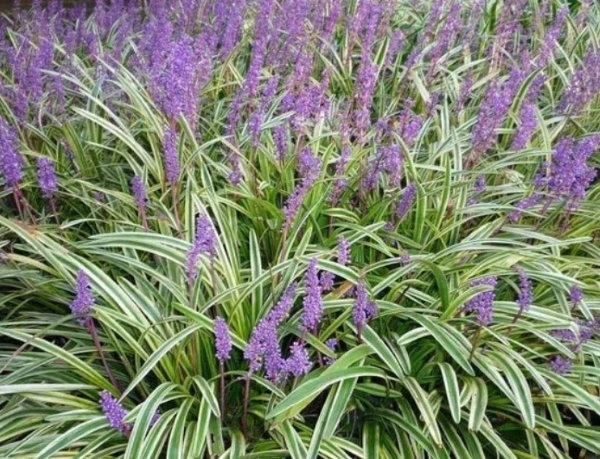
Lilyturf
Botanical Name
:
Liriope muscari
Plant Type
:
Evergreen, herbaceous perennial
Seasons
:
Year-round. Active growth in spring and summer with flowering in late summer and fall.
Sun Level
:
Full sun to partial shade (Prefers partial shade in hot climates).
Soil Type
:
Adaptable to clay, loam, or sand soils as long as they are moist but well-drained.
Germination
:
Best propagated by division; slow to grow from seeds.
P.H. Level
:
Slightly acidic to neutral (5.5–7.0)
Water/Irrigation
:
Average water needs. Drought-tolerant once matured but prefers consistent moisture levels.
Fertilization
:
Not necessary unless using a balanced fertilizer lightly during the growing season.
Habit
:
Clumping, arching, spreading via underground rhizomes
Final Plant Height
:
10–18 inches (25–45 cm)
Spread
:
12–24 inches (30–60 cm)
Spacing
:
12–18 inches apart for proper ground coverage.
Flowers
:
Small, purple, lavender, or white spike-like flowers in late summer to early fall.
Attracts
:
Bees, butterflies, and pollinators.
Uses
:
Borders, edging, ground cover, erosion control, mass plantings, container gardens
Companions
:
Hostas, ferns, astilbes, daylilies, sedum, ornamental grasses
Pruning
:
Pruning involves cutting back old foliage before new growth starts each spring using a sharp mower or pruning shears. This helps maintain appearance and promotes healthy new growth.
Toxicity
:
Non-toxic to humans and pets
Pests
:
Generally pest-free but can be affected by slugs and snails.
Diseases
:
Root rot in poorly drained soil; occasional fungal leaf spots.
Fun Fact
:
Lilyturf is often used as an alternative to turfgrass in shady areas because of its durability and low maintenance.
Additional Info
:
Highly adaptable, Lilyturf thrives in urban environments and can withstand foot traffic, making it a popular choice for landscaping.
Botanical Name
:
Liriope muscari
Plant Type
:
Evergreen, herbaceous perennial
Seasons
:
Year-round. Active growth in spring and summer with flowering in late summer and fall.
Sun Level
:
Full sun to partial shade (Prefers partial shade in hot climates).
Soil Type
:
Adaptable to clay, loam, or sand soils as long as they are moist but well-drained.
Germination
:
Best propagated by division; slow to grow from seeds.
P.H. Level
:
Slightly acidic to neutral (5.5–7.0)
Water/Irrigation
:
Average water needs. Drought-tolerant once matured but prefers consistent moisture levels.
Fertilization
:
Not necessary unless using a balanced fertilizer lightly during the growing season.
Habit
:
Clumping, arching, spreading via underground rhizomes
Final Plant Height
:
10–18 inches (25–45 cm)
Spread
:
12–24 inches (30–60 cm)
Spacing
:
12–18 inches apart for proper ground coverage.
Flowers
:
Small, purple, lavender, or white spike-like flowers in late summer to early fall.
Attracts
:
Bees, butterflies, and pollinators.
Uses
:
Borders, edging, ground cover, erosion control, mass plantings, container gardens
Companions
:
Hostas, ferns, astilbes, daylilies, sedum, ornamental grasses
Pruning
:
Pruning involves cutting back old foliage before new growth starts each spring using a sharp mower or pruning shears. This helps maintain appearance and promotes healthy new growth.
Toxicity
:
Non-toxic to humans and pets
Pests
:
Generally pest-free but can be affected by slugs and snails.
Diseases
:
Root rot in poorly drained soil; occasional fungal leaf spots.
Fun Fact
:
Lilyturf is often used as an alternative to turfgrass in shady areas because of its durability and low maintenance.
Additional Info
:
Highly adaptable, Lilyturf thrives in urban environments and can withstand foot traffic, making it a popular choice for landscaping.
Written by Salome Wapukha – https://www.linkedin.com/in/salome-wapukha-556700193/

